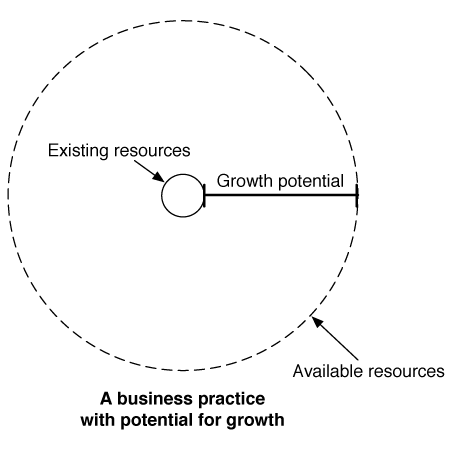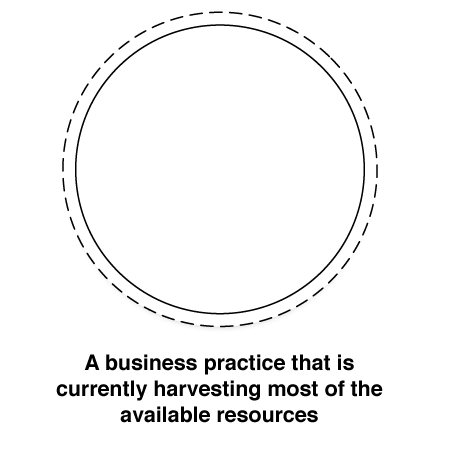Other Readings: Strategies for change
 Image by nickwheeleroz via Flickr
Image by nickwheeleroz via FlickrSpending too much time managing new technologies to deal with your core business? You’re not alone. Let’s look at a brace of Harvard Business Review articles that address change, technological disruption and strategies for coping then close it up with an amusing video.
Moving toward a world in which the constant is change
According to John Hagel III, John Seely Brown and Lang Davison in their HBR article “The New Reality: Constant Disruption,” models of economic and business change followed something along the lines of Stephen Jay Gould‘s punctuated equilibrium model, where significant turbulence is introduced, change in response to that turbulence occurs and then a period of calmer equilibrium follows.
For example, once centralized electric utilities learned how to capture the economies of scale in electricity production and distribution, businesses could focus on how to reconfigure their own operations to take advantage of this new infrastructure, secure in the knowledge that the basic infrastructure was now stable.
Makes sense in a consumer-product world where things are made and physically shipped. However, it doesn’t sound like the world of today where we all have multiple Facebook, LinkedIn, Twitter, MySpace, iTunes and more profiles (how many of you have old Friendster accounts to throw in there as well?) The authors continue by outlining a fundamental difference between the consumer-goods and product driven past to the service-industry and communication driven present:
Today’s core technologies—computing, storage, and bandwidth—are not stabilizing. They continue to evolve at an exponential rate. And because the underlying technologies don’t stabilize, the social and business practices that coalesce into our new digital infrastructure aren’t stabilizing either. Businesses and, more broadly, social, educational, and economic institutions, are left racing to catch up with the steadily improving performance of the foundational technologies.
The end conclusion of the article is: if the above is an accurate picture of the world then we are in for continuous disruption rather than the punctuated equilibrium of the past. The authors believe that the combination of digital computing as the driving technology with the easing of regulations and other policies will create a constant state of change. If you don’t like disruption that’s a pretty scary picture of the future if not the present. Luckily, the authors produced another article.
The core and the edge, defining moving parts in a world of change
In “How to Bring the Edge to the Core,” John Hagel III, John Seely Brown and Lang Davison outline a strategy for business organizations to work within an environment of constant change. They begin by creating definitions for a concept about “edge” vs “core.” This edge/core concept can apply to many aspects of your business and life:
- Markets: existing/profitable market is core while an emerging market is edge
- Personal traits: primary experience/skills/talents are core while developing/hobby/auxilliaries are edge
- Geographies: saturated and developed geography is core while emerging geographic market is edge
- Products/Services: existing commodity-like product/service is core while new/under-developed products and services are edge
- Business practices: established practices have resources and well-developed policies, edge practices operate with few resources or management oversight.
Basically, edges occur anywhere there is growth potential. There may be a practice that is untapped or addresses a currently untapped market.  Core occurs anywhere the potential for growth has already been seized upon. A core business practice is currently capturing most of the available resources and has well defined processes/policies to maintain itself. At the organizational level, the authors define core as “where the money and resources are today.”
Core occurs anywhere the potential for growth has already been seized upon. A core business practice is currently capturing most of the available resources and has well defined processes/policies to maintain itself. At the organizational level, the authors define core as “where the money and resources are today.” 
Integrating edge technologies into the core, an outdated strategy?
When confronted with a new technology or business practice (aka a disruption) some organizations follow a strategy of trying to integrate or absorb the new technologies/methods (edge) into their established practices (core). A logic pattern like this might occur:
- Twitter is a new communication technology.
- Email newsletters are a communication technology.
- Let’s use and measure Twitter the same way we use and measure email newsletter technology.
If we follow through with this line of thinking, we will short-circuit the available growth potential of Twitter for helping with customer service, market research, etc. Here’s another example of a core-absorbing-the-edge strategy, see if it sounds familiar:
- Someone invented a computer thing called a website and all of our competitors are getting them.
- These websites involve computers.
- The IT gurus know about computers, let’s put them in charge of our website.
This line of thinking is how more than one organization put the communication tool with the largest growth potential in the hands of a group which is not traditionally known for its marketing or communication skills. Because these examples are so much fun I’ll give you one more, from the ad agency side:
- Someone invented a thing called a website and all of our clients want to buy one.
- You look at these website things on a screen.
- The television ad production team knows about screens, let’s put them in charge of websites.
Remember those websites with 90 second “skip intros” that took so long to load? Now you know how that happened. When you put the same burdens and requirements of a developed, core business practice onto an edge technology, your success and results will depend on the size of the hammer you’re using to put a the square peg in the round hole.
Core support for edge practices, a strategy for constant change
The authors suggest an alternative strategy: instead of integrating edge practices into the core, you extend support from the core to promising edge practices. You probably caught that last phrase: “promising edge practices.” If we all were adept at identifying the promising edge practices then we wouldn’t much need to read the Harvard Business Review in the first place. The authors do help us out though, here four attributes to define the promising edge practices:
- offer significant headroom for performance improvement
- a large potential user base
- require modest investment for participation at the outset
- offer the prospect of significant short-term returns to support bootstrapping efforts by lots of participants
Note that the phrase “performance improvement” is included in these four attributes. Just because edge practices aren’t held to the same set of criteria as core practices, doesn’t mean there is a blank check on performing edge work. Some method for measuring performance improvement will need to be adopted, even if it is much different than that of your core practices. Assuming you’ve identified an edge practice or technology, what do you do?
To exploit opportunities on the edge, executives must resist the temptation to prematurely integrate edge resources into the core of their operations. Instead, they should determine what resources they can offer to help scale the innovations being developed by edge participants. This could catalyze the development and deployment of growth platforms, platforms that edge participants can then use to more effectively design and deploy new innovations.
Note that the focus is to incorporate as many participants as possible. A core business unit, according to the authors, should be interacting and supporting as many edge units as possible to increase the opportunity for growth and information exchange in a changine world. Here’s that funny video I promised at the beginning: [youtube]http://www.youtube.com/watch?v=uyPDHh4d1Xo&eurl[/youtube]











